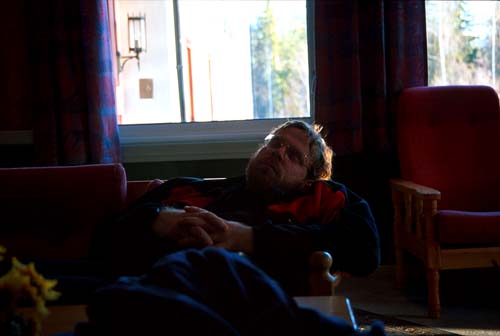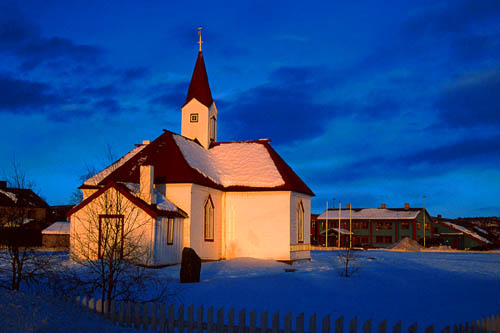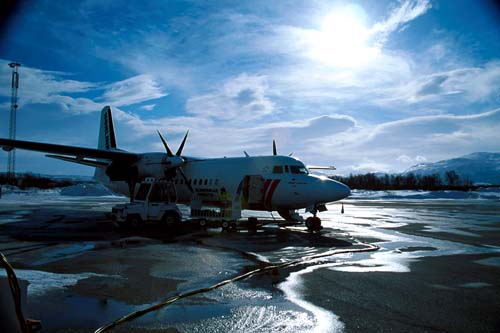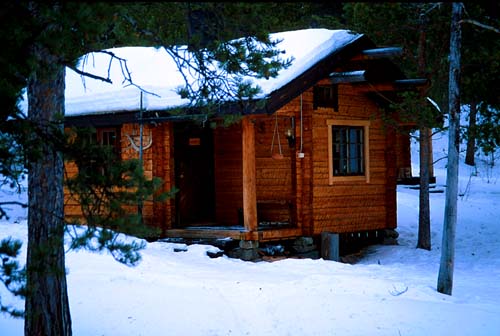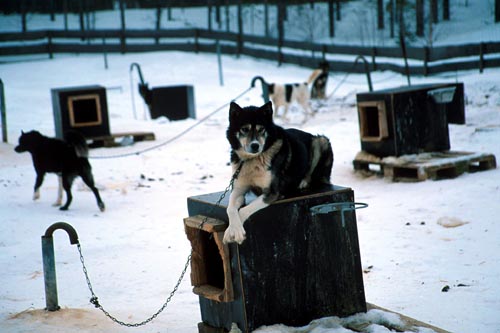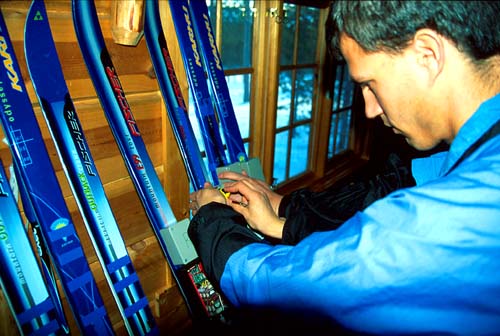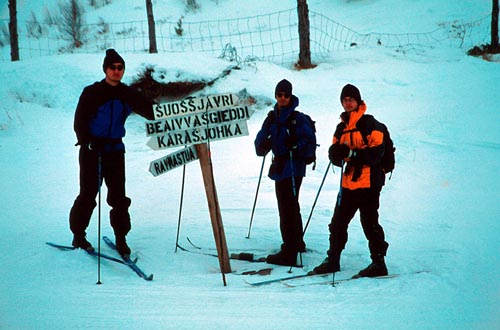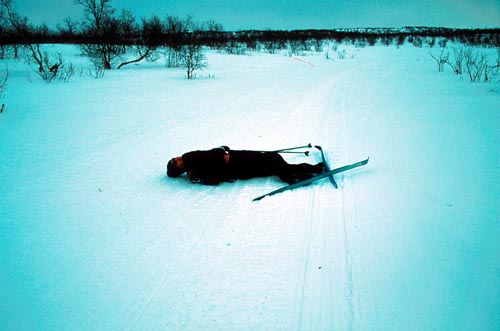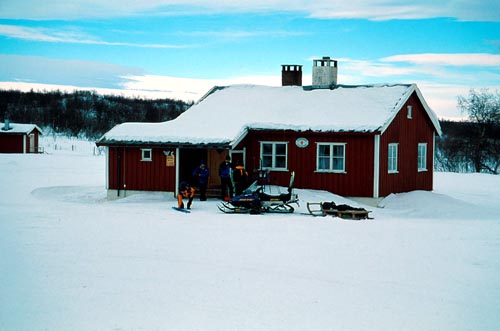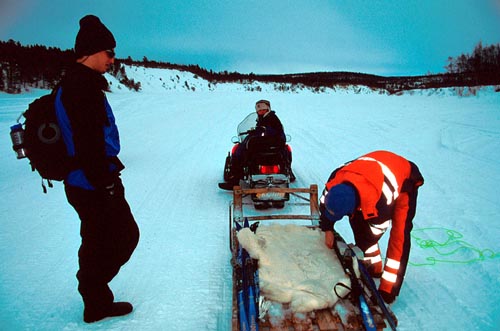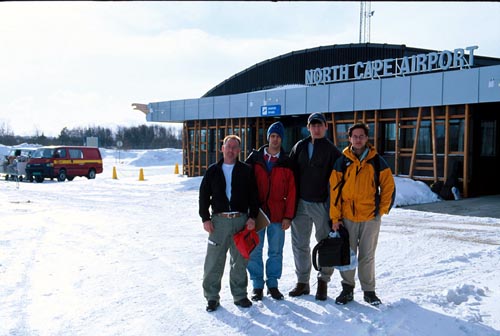The old church in Karasjok, and one of the oldest in Norway. It was the only building not burned by the Nazis during their scorched earth retreat in 1944.
In Karasjok (March 19-23, 2000)
I
have the luxury of an hour to write. Here's the news.
Sunday 3/19 8:20p
Dripping with de-icing goo, our Fokker puddle jumper left Tromsø an hour late
in a snow squall, and landed in darkness and flurries around 9:30pm at Lakselv (N70.03
E24.59). A new north record for the Media Lab.
The Fokker that flies to Norway's far northern airports.
Hertz made it
here before us, and we picked up what may actually be the only car they had to
rent. In this part of the world, rentals come with power cables and engine
block heaters. I doubt it will come to that; the temperature has been
around freezing. Gunnar (Svenn Engholm's assistant) met us in a
pickup truck and we barrelled southwards into the arctic night.
We are a few hundred miles north of the arctic circle at the very top of Norway,
which is itself the northernmost tip of Europe. We came to test some
cross-country ski monitoring equipment in bona-fide arctic conditions, and
preferably in real snow; things that have not been common in New England this
winter. Reliable snow lasts here until May. To put the idea of north
in perspective, the northernmost town in the world is Hammerfest, and that's
only about 60km north of Lakselv. Actually, Honningsvåg, a few miles farther
north on the road to Nordkapp, has now technically claimed "town"
status, so has
usurped the title. Hammerfest was also the first town in Europe with
electric streetlights (1890) to stave off the long night (arctic night lasts
from Nov 21 to Jan 21 there). There is a PGA-blessed golf course not far
from here. MIT is at
N42, and each degree of latitude is about 70
miles, so in rough numbers we are 1900 miles north of home and about 1400 miles
south of the pole.
Some quick Norwegian facts: 4.5m people of whom 45k are indigenous
"Sami" (the famed reindeer herders). 40% of the country is
forested, of which 5% is old growth. Norway produces 2.2% of
the world's fish. There are lemmings, puffins, polar bears (in Spitsbergen
and Svalbord). Largest glaciers and icefields in Europe. The
northernmost real brewery in the world is Mack's, in Tromsø, a town that also
has more pubs per capita than any other in Norway. I am not sure how that
compares with South Boston.
Driving into blackness, we passed Karasjok after about 85km, and another 7km
brought us to Svenn Engholm's husky camp. Karasjok, a town of about 2500 people,
is the capital of the Sami nation. We dropped our things in the cabin and
by about 11:30pm Sunday night we were at Ryba, the local pizza pub. Chris
Newell had run into a fellow named Isaac who was here to design the new Sami
museum, complete with fiber optic displays of starfields and simulated aurora
borealis. Isaac's hair looked like an exhibit, oiled into a conical shape redolent of Sami teepees. "Good luck with the pizza,"
he had said. "I hear it's... below par." Well, nothing
exotic about the pizza -- no reindeer, no salmon, just nondescript pizza with
local Mack's beer to wash it down. Things got more interesting when a
drunken Sami sculptor sat down at our table and struck up a form of
conversation. "Not so good with english, are you?" he remarked.
The rest was mostly unintelligible gibberish. The twinkling glow from the
mirrored disco ball and the 70's love music in the next room completed the
ambience.
Monday 3/20
9am. Temperature is unseasonably warm here -- 39F this morning; normal is
more like -10 to -20F. Last year they had a cold snap in March around
-50F.
There are half a dozen cozy and beautifully built spruce cabins sprinkled around
the main pen that houses maybe three dozen huskies. Ours has beds just
below the eaves and a few beds below. Sealskins, foxes, and other animals
are hanging on the walls. Sami boots, reindeer skin coats and pictures of
dog teams in action decorate the place. There's a wood stove, a hotplate,
a fridge, and a microwave. A stump with a slab of slate makes a table.
There is also electricity: Debski, Lau, and Wheeler have unpacked the
electronics, scopes, and soldering irons and are deep into debugging. We
expect hardware assembly to continue throughout the day, with ski testing this
evening.
Sven dropped by, and we learned a little about the nuances of world class
dogsled racing. Sven has won the European equivalent of the Iditarod 11
times and is, thankfully, sponsored by a dogfood company. There appear to
be about three dozen dogs in his kennel, and the breeds are a 3:1 mixture of
Alaskan husky and pointer. He examined the ski sensing systems with
intrigue. His main impediment in competition is not technical. It's
legal: Norway imposes a four month quarrantine on pets, which means after an
undertaking like the Iditarod his dogs are idle and cannot be exercised for 4
months; not the way to keep a world-class team in top form. Nevertheless,
he was intrigued by the ski sensing systemsand wondered how one could measure
the pulling efficiency of the dogs on the team.
This husky looks a lot like Tasha
Chris and I nipped into town. The museum was closed. The
tourist center was under construction. The art center was not to be found.
We drove over the frozen Karasjok river and past a little wooden church that was
built in the early 1800's (it is the oldest in Finnmark, and was the only
building not destroyed by the Nazis during their scorched earth retreat in
WWII). It was closed. The local Sami radio station, which was not
closed, plays a bizarre mix: "Staying Alive" sung by Norwegian
chipmunks in a rap style was memorable. Spice Girls and something that
sounded like Norwegian polka music were not.
Dinner was at the local Rica hotel. It features an underground
traditional Sami restaurant, but apparently Samis don't eat out in the winter.
Reindeer was the popular (unanimous) course for dinner. Nobody had room
for dessert although the cloudberries sounded tempting. The local lounge
band, "Stop," played chestnuts from the 60's. Apparently (although
we learned this fact too late for it to be of any use) the place the locals all
go to eat is down the road just over the border in Finland.
It is snowing lightly again, about 28F, and at 11:30pm the ESP gang are back at
the rustic lab bench, assembling the rigs. Tomorrow we will ski 22km to a
mountain cabin for an overnight. It is Thursday 3/23 1:26am. About
30 huskies burst into song, yowling at the moon: what a wild, eerie choir that
is. Two hours ago we stood outside, staring at the aurora borealis. This
was not an auroral storm, just a drizzle, but the sky overhead was decorated
with greenish curtains that brightened and dimmed and brightened again as they
wafted across the sky. Special effects. A good time to summarize the
events of the last two days, as we ship out Thursday.
Tuesday 3/21 2p
After a morning of debugging and assembly, we set out on a ski trek to a cabin
24km (15 miles) up in the hills. "Should take about four hours," said
Sven.
Following a snowmobile trail WSW, we eventually found our way past ice glazed
roads, through knee-deep old snow in farmer's fields, and then down to the
Karasjok river. In wintertime, rivers are highways for snowmobiles, and
the combination of traffic plus scouring winds and a melting/freezing cycle had
reduced the snow to a pretty crufty icy crud. Skiing was slower than
walking on this stuff.
We were testing two ski systems. Matt Debski had a wired sensor system
with modules on both skis to measure boot dynamics (angle of bend and downward
heel pressure), ski characteristics (compass bearing, roll/yaw) and skier data
(body temperature, GPS location, weather data). Mine was wireless, using a new
radio network designed by Andy Wheeler. In fact, there were about two
dozen microprocessors networked around my body. Skis are a fine argument
for a wireless sensor network: it's always a nuisance to put skis on and take
them off, but fiddling with wires that run from the skis up through your clothes
and around into the processing module in the backpack is really irksome,
especially after a face plant, when the wind is whipping, and frozen fingers are
struggling with tiny connectors. Another is the collection of irritating
disconnected things I carried: a Garmin GPS that measures position well but
can't really tell direction or altitude; a Brunton weather gauge that has a
decent wind meter but a flakey altimeter and a very slow thermometer (and no
external connector or memory); a Canon camera that has a data back but only to
wreck images with time stamps. None of it interoperates. The idea here was
to collect lots of data about physiological and (s)kinematic activity in an
integral way, then upload and analyze using the Power of the Internet.
Matt Debski adjusts the sensor packs.
Skiing along the river we ran into a Sami family indulging in their favorite
pasttime: skijoring. A 900m oval racing oval had been marked with birch
sprigs. The racer, wearing skis and goggles, hangs onto a rope for dear
life because the other end is attached to a galloping reindeer. Top speed:
about 50km/h! In competition they do it Ben Hur style. This
suicide sport makes bobsledding look like the soapbox derby; our man whipped
around a lap in 1:15. The reindeer was exhausted, panting hard, tongue
hanging loose. As we left I watched a tiny little girl lead Rudolph back
to the family herd. I will always regret not begging or bribing these good
folks to let ... Matt Debski give it a try.
Looking for the trail to Ravnastua.
As we headed on, Gunnar (Sven's assistant) whizzed by on a snowmobile, driving
up to the high cabin with our sleeping bags and computer tools. Which
basically meant that turning back and heading for home was not an option: our
beds were 20km up in the hills. Our trail continued along the river for
6km or so before turning north, crossing the road, and then climbing steeply
through a pine forest.
The next 5 or 6km ascended about a thousand feet. Progress was slow in
that icy crud, but we began to emerge from the boreal pine forest and into a
more barren plain with a few scrubby bushes. Gunnar and a friend came
buzzing down on the snowmobile. This time Gunnar was the passenger.
The driver wore a hat, oversized mitts and goggles. His cheeks were frosty
red. "He is a maniac," Gunnar said in his lilting Norwegian
accent, referring to the driver. "He's an animal. In fact, when we
get home I shall chain him up in the dog yard with the huskies." Snow
began to fall. Before he left, Gunnar said that following the trail was no
problem, and after we crossed a couple of big lakes we'd be halfway there.
Matt Lau perfecting his technique.
No sign of a lake, and as we pressed on things took a turn for the worse when
the trail began to head up a steep, barren hill. Snow fell harder, the
headwind picked up to a nasty 30-40mph according to our little handheld
anemometer, and the trees and shrubs disappeared. We spent nearly two
frosty hours slogging into that biting wind, and with darkness falling, things
were becoming miserable. While Debski and Lau paused to add more layers, a
mitten and glove slipped loose and blew up the hill -- I sprinted off on my skis
and after a mad dash, was barely able to spear them with my pole. Losing
your mittens is a good way to lose your fingers. Working my way back to
the trail another mitten blew hopelessly by. I kept my spirits up by
recalling cheerful stories, like Jack London's "To Light a
Fire." Or the story of the lost patrol of Constable Moodie whose dog
team mushed 500 miles up the Yukon only to run up the wrong fork of the Rat
River, missing the town by a few miles, and starving to death in a
snowstorm. Or the recent news of a cemetery a few miles north of us,
containing the bodies of an entire town that had been wiped out in the deadly
1918 flu epidemic. The virus is still there, lurking in the permafrost.
As the sun gradually set we had been at it for about 4 hours, and were just
reaching the lake. March 21 is the equinox, so even up here we got our 12
hours of daylight. Of course, we had burned the first 9 hours of it
working on the electronics.
The zen novelty of night skiing wears off quickly. I was struck by how
relatively bleak the place was. No birds or animals. No happy Sami
clans with sleighs and jingle bells. Just a few scruffy looking trees,
mostly dark and getting colder. By about 8:30 in the gloom I began to
think that wandering onto the wrong trail would not be good. We finally
got a pat on the back from Mother Nature: as we gradually passed into a more
sheltered, not-so-windy place, a golden full moon began to rise behind us, warm
light filtering through the clouds, and in the sky ahead we saw a few faint
greenish curtains of the aurora borealis. It was not much to go on, but
since we had been told it was a four hour ski and hadn't brought chocolate or
snacks, and had spent over six hours already in pretty crummy conditions,
wondering whether our navigation algorithm would get us to the cabin in the
middle of nowhere ("Let's go left at every other fork in the trail"),
the hint of an aurora was pretty uplifting.
The cabin at Ravnastua the next day: a welcome sight.
After an exhausting ski into a gloomy night, there's nothing quite so reassuring
as finally seeing a few lights from a warm cabin winking through the
trees. It was 9:37 when we arrived, after about 7h30 of plugging.
Ravnastua is one of three or four cabins that the Norwegian government still
maintains year round. This one was run by a troll-like little man with
curly-toed reindeer boots who spoke not one word of English. I found him
in the kitchen, stabbing a footlong knife blade into cans of beans. I
guess the Swiss army approach is for sissies up here. A few rounds of
charades got us a big pot of stew, a loaf of rye bread to pour it on, and half a
dozen sodas. Dessert was a Norwegian "sjokolade", including
"m's" (just "m's", a quaint brand mutation), "Kvikk
Lunsj" (more like a Kit Kat than a quick lunch) and a couple other odds and
ends. Fact is we would have eaten dog food at that point, and our guess
was the dog food was the salmon hanging out to dry, which sounded better than
what we ate. Chris Newell opened a hazelnut chocolate bar and slathered
butter all over it with gusto. I ate a couple sugar cubes. It would
all burn off in no time. Loaded with carbos, lipids, and sugar, we made
for bed.
Andy and the Matts took an hour to dump the data from our skis. And it took
about an hour because we managed to log about 4mb of records, but the smartmedia
cards currently transfer at 19200bps. I was impressed that, after a pretty
gruelling day, anyone would have the ergs left to tinker. The exciting
news is that both systems worked, including the new wireless radio skis -- a
satisfying end to an exhausting day. Whoohoo!
Wednesday 3/22
The morning was warm (about freezing) and clear. Breakfast was bread, jam,
cheese (including the caramelly Norwegian Gjeitost) and juice. What we
didn't eat, we packed for lunch. After a requisite couple hours to fiddle with
electronics, we left around noon for the ski back.
This was much more pleasant. The weather was good. What little wind
was at our backs. We could see the trail -- how nice. We had eaten,
and loaded backpacks with chocolate. And we were basically heading down, not
up. The ridge that was such a frostbite zone yesterday was today just a
pleasant downhill grade, and we poled along easily. Gunnar passed by on
the snowmobile, carrying our mobile electronics laboratory back down, and Chris
Newell happily hitched a ride on a reindeer blanket back to camp. "I
don't like to ski," said Gunnar. "That is why we have 43
dogs."
The downhill became a real yodel run, with a few steep and mogully
pitches. According to the GPS I hit 34km/h; someone really should invent a
better skidometer. It was more ice than snow, and a pretty fast scrape to
the bottom.
Gravity is our friend. We reached the river in about 3 hours, and began
the last leg back to the cabin. Gunnar showed up again to ferry us home,
saving us from the last flat, useless icy stretch.
Gunnar prepares the sled with a soft bed of reindeer hides.
This time we delayed the download of data -- and opted for the sauna
instead. Sven had built a cozy dry sauna cabin near the main house.
It was a Good Thing.
Having exhausted the gourmet dining possibilities in Karasjok, we drove into
Finland. "Olen Suomenlainen" means "I'm a Finn," which
would be good to know at the next border. Even the Finnish soldiers at the
border admitted that the food was better in Finland. Highlight of the
meal: pizza with reindeer and blue cheese. Not vegetarian, but it was
terrific.
Thursday 3/23
A travel day. We nipped into the local Sami museum, picked up some goodies
from the gift shop, said farewell to Isaac and his team of wacky exhibit
designers from L.A. as they were installing a huge fiber-optic bird's nest that
would be an auroral simulation, and had a beautiful drive on a sparkling sunny
day back to Lakselv. It was nice to finally see the surroundings, and some of
the mountains and valleys are beautiful. The Lakselv airport (N70.03.989
E24.59.012) is actually called The North Cape Airport and is the main
hub for tourists headed to Nordkapp, of which there are many.
While the gang checked in, I refuelled the rental car (travellers take note:
half a tank of gas for $38). Spectacular views of the Alta fjord on the way back
to Tromso.
Chris Newell, Matt Debski, Matt Lau and Andy Wheeler.
We unpacked at the airport Radisson (a fine hotel), scrubbed up, took the
beautiful bullet train into Oslo (a lovely 20 mins) and met up with Ellen
Nedrebo who presides over the MIT Club of Norway. A blowout dinner at the
"Second Floor" (above the Continental hotel, and the old Theaterkafe,
it is a fabulous place) was followed by a little carousing at a private
club. Ellen is working on a new "e-topia" of sorts, a futuristic
community for creative enterprises (sort of a Silicon Fjord). This project was
just approved and funded by the government. We met a couple of designers who
seem to be the talk of the town now -- they are running a business doing
web-based graphic design for international clientele. Razorfish is a big
word in that part of the world.
I had a glass of "Linie" aquavit (a special aquavit that has travelled
to Australia and back via boat, crossing the equator -- the Linie --
twice). This suggests that not only could the Norwegian shippers not sell
it in Australia, even the thirsty sailors would not drink it.
By 2am I was back at the hotel working. All in all, a very healthy and
productive little trip.
The next month will be spent working on the data and systems, and digesting the
results.
